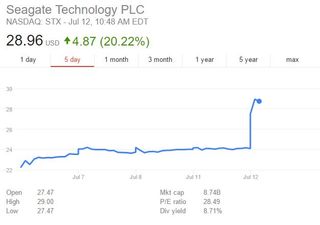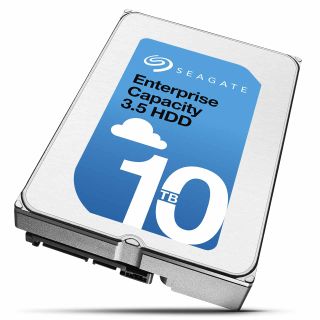Seagate Q4 Guidance Up, Announces Additional 6,500 Layoffs To Keep It That Way

Seagate released selected preliminary financial information for its fiscal 2016 fourth quarter. The results are surprisingly positive, with revenue estimated at $2.65 billion. The revenue guidance represents a 9.6 percent year-over-year decline but beats Seagate's original $2.32 billion projection by $330 million. The earnings are a positive sign for the company, especially considering that Seagate's woes began earlier this year when it missed its projections by $100 million.
The gains stem from increased HDD demand, which is a ray of sunshine in an otherwise gloomy HDD market. Seagate, like the other HDD vendors, is beholden to the rocky desktop PC market that has plunged relentlessly for years. The most recent quarterly Gartner report indicated that desktop PCs declined 5.2 percent globally, but actually grew by 1.4 percent in the U.S.
This is the first time the U.S. has experienced growth in five quarters.
The future looks upbeat, as well; most PC purchases traditionally occur in the third and fourth quarters. Any sign of recovery in the desktop PC market is good news for the HDD vendors, as most desktop PCs still do not ship with SSDs.
The rocky desktop PC market continues to suffer globally, but Seagate found some relief in better-than-expected enterprise HDD demand. The company is now selling a competitive 10 TB helium-based HDD, which might have improved its position. The company sold approximately 37 million drives, or 62 exabytes of storage, with an average capacity of 1.7 TB and an average selling price of $67.

Seagate announced that it was relieving itself of 1,600 workers last week as part of "The Plan," which is the creative name for the company's restructuring efforts. In tandem with its preliminary financials, Seagate announced that it is laying off an additional 6,500 employees, or 14 percent of its global workforce, which brings the layoff casualties to 8,100. Seagate projected that it will cost $164 million to send the employees packing by the end of the fiscal year 2017, but that the reductions will allow it to increase its margins to the 27-32 percent range. Seagate currently employs more than 46,000 people.
The company also predicted a gross margin of 25 percent, and the encouraging words sent Seagate stock skyrocketing; it is currently trading up more than 20 percent. Many of Seagate's investors divested their stock due to what they perceived as Seagate's poor visibility into future supply and demand, but its preemptive cuts and restructuring efforts appear to be consoling the skittish.
Stay on the Cutting Edge
Join the experts who read Tom's Hardware for the inside track on enthusiast PC tech news — and have for over 25 years. We'll send breaking news and in-depth reviews of CPUs, GPUs, AI, maker hardware and more straight to your inbox.
Seagate sees a glimmer of hope, but it is going to take much more to recover fully from the beating it took earlier this year when its shipments cratered and it announced a $100 million shortfall. Investors punished Seagate's stock as the company shed value by the billions ($10.39 to $7.58 billion).
Seagate is refocusing on its high-margin and high-density enterprise HDD offerings, which should provide a welcome shelter from the increasingly hostile SSD penetration in the notebook segment.

Paul Alcorn is the Managing Editor: News and Emerging Tech for Tom's Hardware US. He also writes news and reviews on CPUs, storage, and enterprise hardware.
-
3ogdy Reply18268554 said:This still won't cut it to survive... They need something new...
I agree. Something new...hmm...such as:
1. Designing actually reliable products?
2. Not lying to customers telling them their HDD is out of warranty even though it was within legal warranty (less than 2 years old and no tampering) and actually denying to fulfill warranty obligations while removing the HDD from their "serviceable through warranty" list. Lawsuit filed, legal battle incoming.
3. Not making customers pay over $1200 in order to send their piece of sheet to their Netherlands laboratory, recover the data and send it back?
4. Providing a useful warranty - maybe longer than what their HDDs are secretly designed to withstand (cough, 2 years on average, cough) - a.k.a. "Oh, my HDD is dead, but it's barely been used, let's return this thing - oops, carefully scheduled failures in the way, not gonna be possible.
That should get things going for Seagate for now. Then, maybe they could release an SSD and not make the mistakes detailed above when it comes to dealing with their own customers?
I, as a Seagate customer and computer technician, refuse to ever put any current or future Seagate products in my computers or in computers I build.
Yeah, Seagate, keep it that way.
-
Razec69 3ogdy,Reply
The sad reality is though all HDD manufacturers are doing the same thing. Hell all manufacturers are.
Seagate and WD bought up all the previously reliable HDD makers, Maxtor, Samsung, and Hitachi, among others.
I won't swear by any brand anymore though. I've had a 1TB Seagate that lasted 5 years, 2x 3TBs in RAID that have lasted so far 2 years with no issues. I may be one of the lucky few, but lets not Jinx that.
But on the other hand, I have a WD My Book 640GB that has lasted over 6 years.
But when you look online at reviews no matter what website you get a bag of dicks for reviews. All shapes and sizes.
Since most websites put all general makes and capacities into one correlated review section, you get on average a 3-4 star rating for both WD and Seagate's top drives. Those being the Black and Barracuda drives respectively.
I've lost respect for both companies honestly, as both have lowered their warranties substantially. WD going from some of the better warranties to making them nearly useless especially for their lower end drives i.e Blue, Red, and Purple. Seagate as well offering crap models from different fabrications.
But that is what happens when 2 companies collectively control 90% of the HDD manufacturing. -
stevenrix #1 We are running out of Helium on this planet. Helium is found on stars, they are going to drive prices higher on hard-drives.Reply
#2 The failure rates on Seagate hard-drives is not always good. I belong to those disappointed customers that will never go back to Seagate no matter what.
#3 Seagate may lead the top end market but their prices are too high: i don't want to pay $660 for a 10 Tb drive.
#4 If you have to lay off your workers to raise your net income, then maybe this company does not deserve to survive.
Just my 2 cents.
Most Popular






